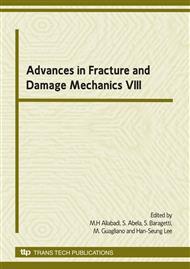p.533
p.537
p.541
p.545
p.549
p.553
p.557
p.561
p.565
Effect of Fiber-Matrix Integration on the Fracture Behavior of Aluminosilicate Fiber Reinforced Clay-Kaolin Matrix Composites
Abstract:
Different amounts of fiber added samples were prepared by standard ceramic processing routes and sintered at different temperatures. Although powder packing characteristics of the matrix material were negatively affected with increasing fiber content; certain improvements were observed for the density, MOR and water absorption values both for green and sintered states. Fracture surfaces of the samples after three-point bending test were investigated via detailed SEM observations and phase analyses were performed by XRD measurements. It is found that phase transformation controlled fiber-matrix integration starts with increasing sintering temperature and degree of bonding between fiber/matrix interfaces can be arranged by selecting optimum sintering temperature. Aluminosilicate fiber addition was found efficient for improving mechanical properties of clay-kaolin matrix and the mechanism of the improvement can be grouped into two categories i.e. (1) brittle fiber – brittle matrix interactions via well known pulled-out, crack deflection and bridging mechanisms prior to fiber-matrix integration (2) further densification via phase transformation controlled fiber-matrix integration after high sintering temperatures.
Info:
Periodical:
Pages:
549-552
Citation:
Online since:
October 2009
Authors:
Price:
Сopyright:
© 2010 Trans Tech Publications Ltd. All Rights Reserved
Share:
Citation:


